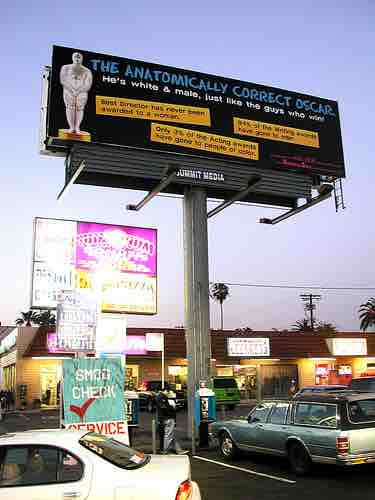Background
A strong relationship between the arts and politics has always occurred across cultural boundaries and throughout history. Various responses to contemporaneous events and politics from the arts can take on political as well as social dimensions, becoming themselves a focus of controversy and even a force of political as well as social change. The 1990s saw a continuation of political art around the world. Stigmatized communities such as racial minorities, women and the LGBT community all created what might be termed political art, that is, art which was being created in opposition to the patriarchy.
The notion that personal revelation through art can be a political tool, guided activist art in its study of public dimensions and private experience. The strategies deployed by feminist artists paralleled those of activist artists. Such strategies often involved "collaboration, dialogue, a constant questioning of aesthetic and social assumptions, and a new respect for audience," and were used to articulate and negotiate issues of self-representation, empowerment, and community identity.
The Guerrilla Girls
The Guerrilla Girls are an anonymous group of feminist, female artists devoted to fighting sexism and racism within the artworld. The group formed in New York City in 1985 with the mission of bringing gender and racial inequality in the fine arts into focus within the greater community. Members are known for the gorilla masks they wear to remain anonymous.
Throughout their existence the Guerrilla Girls have utilized protest art to express their ideals, opinions, concerns, and to bring revenue into the group. Their posters, which now are in the collection of the museum they originally protested against, the Museum of Modern Art, among others, are known for their bold statements such as, "When racism and sexism are no longer fashionable, what will your art collection be worth? " In the early days posters were brainstormed, designed, critiqued and posted around New York. Small handbills based on their designs were also passed out at events by the thousands.

Guerrilla Girls Billboard
Guerrilla Girls billboard in Los Angeles protests white male dominance at the Oscars in 2009.
In 1990 the group designed a billboard featuring Mona Lisa that was placed along the West Side Highway and was supported by the New York City public art fund. For one day, New York's MTA Bus Company also displayed bus advertisements asking, "Do women have to get naked to get into the Met Museum? Stickers also became popular calling cards representative of the group. In the mid-1980s they infiltrated, the Guggenheim Museum bathrooms, without masks to maintain anonymity, and placed stickers about female inequality on the walls.
Since 2002, Guerrilla Girls, Inc. have designed and installed billboards in Los Angeles during the Oscars to expose white male dominance in the film industry, such as: "Anatomically Correct Oscars," "Even the Senate is More Progressive than Hollywood," "The Birth of Feminism, Unchain the Women Directors. " Guerrilla Girls have also published books that include their statistical data, protest arts and goals regarding inequality in the art world. In 1995, they published their first book, Confessions of the Guerrilla Girls.
LGBT Rights and the AIDS Crisis
The AIDS Crisis that started in the 1980s led to increasing stigma against the lesbian, gay, bisexual, and transgender (LGBT) community, which in turn protested with political art and activism.
The LGBT community responded to the AIDS crisis by organizing, engaging in direct actions, staging protests, and creating political art. Some of the earliest attempts to bring attention to the new disease were staged by the Sisters of Perpetual Indulgence, a protest and street performance organization that uses drag and religious imagery to call attention to sexual intolerance and satirize issues of gender and morality . At their inception in 1979, a small group of gay men in San Francisco began wearing the attire of nuns in visible situations using high camp to draw attention to social conflicts and problems in the Castro District.
One of their most enduring projects of the Sisters of Perpetual Indulgence is the NAMES Project AIDS Memorial Quilt, in which members who have died (referred to as "Nuns of the Above") are immortalized. Created in the early 1990s, the quilt has made history several times, being flown around the United States for local displays.
The AIDS Memorial Quilt
The NAMES Project AIDS Memorial Quilt, often abbreviated to AIDS Memorial Quilt, is an enormous quilt made as a memorial to celebrate the lives of people who have died of AIDS-related causes. Weighing an estimated 54 tons, it is the largest piece of community folk art in the world as of 2016.
Street Art
Street art is an umbrella term defining forms of visual art created in public locations, usually unsanctioned artwork executed outside of the context of traditional art venues. The term gained popularity during the graffiti art boom of the early 1980s and continues to be applied to subsequent incarnations. The terms "urban art", "guerrilla art", "post-graffiti" and "neo-graffiti" are also sometimes used when referring to artwork created in these contexts .
There is a strong current of activism and subversion in urban art. Street art can be a powerful platform for reaching the public and a potent form of political expression for the oppressed. Some street artists use "smart vandalism" as a way to raise awareness of social and political issues, especially around issues of race and racism. Street artists sometimes present socially relevant content infused with aesthetic value, to attract attention to a cause or as a form of "art provocation". Street art is a controversial issue: some people consider it a crime, others consider it a form of art.